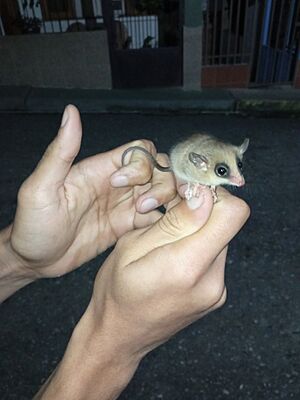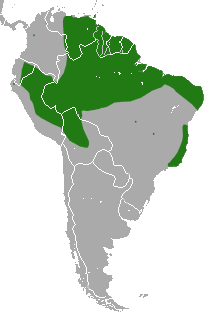Linnaeus's mouse opossum facts for kids
Quick facts for kids Linnaeus's mouse opossum |
|
|---|---|
 |
|
| Conservation status | |
| Scientific classification | |
| Genus: |
Marmosa
|
| Species: |
murina
|
 |
|
| Linnaeus's mouse opossum range | |
| Synonyms | |
|
Didelphis murina Linnaeus, 1758 |
|
The Linnaeus's mouse opossum (scientific name: Marmosa murina) is a small, furry animal from South America. People also call it the common mouse opossum or murine mouse opossum. It belongs to a group of animals called marsupials, just like kangaroos and koalas!
Contents
Where Does It Live?
The Linnaeus's mouse opossum lives in many parts of South America. You can find it in countries like Colombia, Venezuela, Brazil, and Peru. It also lives in Trinidad and Tobago and French Guiana.
These tiny opossums like to live near forest streams. They can also be found close to where people live.
Daily Life and Habits
This opossum is a nocturnal animal. This means it is active mostly at night. During the day, it finds safe places to rest. It might hide in a tangle of twigs on a tree branch. Sometimes, it uses a tree hole or an old bird's nest as its shelter.
What Does It Eat?
The Linnaeus's mouse opossum eats many different things. Its diet includes insects and spiders. It also likes to eat small lizards. Sometimes, it will eat bird's eggs and baby birds (chicks). Fruits are also a part of its diet.
Reproduction and Young
Female Linnaeus's mouse opossums are pregnant for about 13 days. This is a very short time! After this, they give birth to a litter of 5 to 10 babies.
Special Defense Trick
If a mouse opossum feels it is in danger, it has a clever trick. It will "play dead"! It even makes itself smell like it is no longer alive. This can fool predators into leaving it alone.
Appearance and Features
The Linnaeus's mouse opossum has soft, smooth fur. Its fur is usually a pale beige or gray color on its belly. Its face looks like it has a black mask around its eyes. Its eyes are quite large and stand out. Its ears are very upright, pointing straight up.
One of its most interesting features is its tail. The tail is much longer than the rest of its body. Female opossums can even use their tails to carry leaves!
This opossum is quite small. Its body is about 11 to 14.5 centimeters (about 4 to 5.7 inches) long. Its tail can be even longer, from 13.5 to 21 centimeters (about 5.3 to 8.3 inches). It weighs around 250 grams (about 8.8 ounces).


